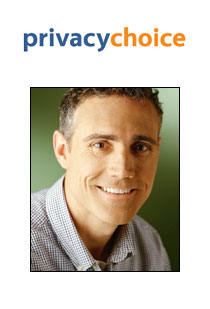 Jim Brock is CEO of Privacy Choice, a web tools company focused on consumer privacy.
Jim Brock is CEO of Privacy Choice, a web tools company focused on consumer privacy.
AdExchanger.com: First, please share a bit of background on you. And how did you come up with the idea for Privacy Choice?
JB: I’ve always been in and around ad-supported media, as a Yahoo! executive and as a founder, investor or advisor to new media companies since 1994. (LinkedIn profile) I started PrivacyChoice after my wife had a spooky experience with health-related targeted ads. It seemed like privacy technology wasn’t keeping up with targeting technology. I started with a very simple, universal opt-out tool that was an instant hit with consumers. We now manage preferences for well over a quarter-million people, and have launched nearly a dozen other tools and resources: A comprehensive database of ad company policies and certifications, several bookmarklets and add-ons to monitor tracking activity and to maintain opt-out and opt-in choices, a best practices checklist for ad targeting, a free site-scanning service and a seal program for websites to monitor and certify their third-party data practices, and a new experimental service for consumers to see and control their ad profile in its entirety. These all leverage a common data set and preference platform, and we’re just getting started.
What problem is Privacy Choice solving?
Our mission is to make privacy choices understandable and actionable. To further the consumer mission, we also make tools for websites to keep themselves and their users better informed of the third-party privacy practices that come into play through ad and data relationships. If websites make smarter choices, everyone benefits.
The PrivacyChoice Bookmark is a great example of how we serve the consumer mission: with two clicks, the consumer can control ad targeting on over 100 ad and data companies, and instantly refresh and update that choice any time they want. We give the consumer the choice to only opt-out of ad companies that are not compliant with the new framework. If they sync bookmarks across computers or devices, those choices can come right along.
Who do you see in the competitive set and how do you differentiate? Do you consider Better Advertising or TrustE as a competitor, for example?
It’s pretty early but our approach is distinguished as highly consumer and choice-centric, and we’ve taken an open approach to licensing our platform and data, including with partners like TRUSTe. Through the PrivacyChoice Blog I have advocated an open approach to the dialog about best and worst practices in the marketplace. Consumers (and regulators for that matter) can smell a non-transparent, “back room” process a mile away. Companies can regulate themselves effectively only if that happens in the open so everyone can see successes and failures as they happen.
What is the revenue model for Privacy Choice? How is the company funded and how many employees do you have today?
The project has more than a dozen ongoing contributors, including web application developers, add-on authors and researchers. We collect fees for the license of our platforms and data, and have started offering subscription services for websites to monitor and certify their third-party data practices.
Are browser and server-side cookies a bad thing for consumers?
Cookies are incredibly useful to the browsing experience, as are other methods for a website or ad platform to store data locally. Cookies can be very helpful as a means for the user to signify their preferences about online tracking, as long as those preferences can endure, either through an add-on or something like our new Privacy Bookmark.
The fact is, there are plenty of ways to track users without using cookies. The task for the industry is to define the rules for preference setting and provide processes to ensure those preferences are observed on the back-end.
What are your views on self-regulation by the advertising industry? Can it work?
The new framework for enhanced notice and choice has great promise, so long as a critical mass of companies in the ad delivery chain adhere to it. I’m looking for three indicators of success for the new program:
- The consumer experience needs to be terrific and sincerely designed to educate and effectuate consumer intent in a few clicks, even if that means a global opt-out, and those choices need to be durable.
- The Network Advertising Initiative or other organizations need to provide meaningful and transparent review of back-end processes, where it really matters most, and it needs to be completely transparent when companies are failing to meet their responsibilities.
- The 100+ companies who are not actively compliant with the framework need to be shunned, which is to say, their data should be considered contaminated and not available for trading by the companies who are complying. NAI members shouldn’t transact with non NAI companies, and big companies like Google need to kick non-compliant companies out of their exchanges.
Looking ahead what milestones would you like Privacy Choice to have achieved a year from now?
It’s simple: we want to give more consumers a feeling of control over how marketing affects them and their own data profile. Success means delivering this kind of experience to millions of consumers, directly and through
partners and publishers.
Any growing trends that you find troubling in regards to consumer privacy and ad targeting today? Do you expect government legislation?
There will always be some companies who refuse to invest enough in consumer privacy, but they won’t survive long in a transparent marketplace because ad buyers won’t accept it. If I’m troubled by anything, it is that industry leadership sometimes wants to keep non-compliance behind a curtain, which I think just breeds more distrust and increases the regulatory overhang.
Is Privacy Choice a US-only solution? Any plans to expand internationally?
We already cover a dozen or more ad companies outside of the US, and well over 10% of our consumer traffic comes from outside the US. Because the core opt-out and opt-in methodology is the same, we can cover consumer preferences globally, but at some point in the next year we will look at localizing our consumer experience in other languages.
Follow Privacy Choice (@privacychoice) and AdExchanger.com (@adexchanger) on Twitter.












